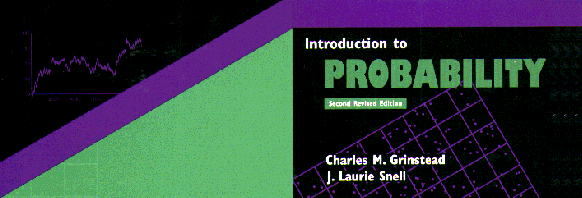
This introductory probability book, published by the American Mathematical Society, is available from AMS bookshop. We are pleased that this has made our book more widely available.
We are pleased to announce that our book has now been made freely redistributable under the terms of the GNU Free Documentation License (FDL), as published by the Free Software Foundation. Briefly stated, the FDL permits you to do whatever you like with a work, as long as you don’t prevent anyone else from doing what they like with it. This is the same license that is used for the Wikipedia.
Thanks: We owe our ability to distribute this work under the FDL to the far-sightedness of the American Mathematical Society. We are particularly grateful for the help and support of John Ewing, AMS Executive Director and Publisher.
Our book emphasizes the use of computing to simulate experiments and make computations. We have prepared a set of programs to go with the book. We have Mathematica, Maple, and TrueBASIC versions of these programs. We also have experimental versions of the programs as Java applets written for us by Julian Devlin. We would be happy to provide the solutions to all of the exercises to instructors of courses that use this book. We would appreciate hearing from you concerning additional corrections and suggestions for improvement.
Contributions to the GNU version of our book.
Kemeny’s Constant: Peter Doyle.
This discussion relates to Exercise 24 in Chapter 11 concerning “Kemeny’s Constant” and the question: Should Peter have been given the prize?
Hedging Huygens: Peter Doyle.
In the historical remarks for section 6.1, Grinstead and Snell describe Huygen’s approach to expected value. The were based on Huygen’s book The Value of all Chances in Games of Fortune. Peter reworks Hygen’s discussion to show connections with modern ideas such fair markets and hedging. He illustrate the limitation of hedging using a variant of the St. Petersburg Paradox.
A local limit theorem for sampling without replacement: Mark Pinsky
In Feller’s Introduction to Probability theory and Its Applications, volume 1, 3d ed, p. 194, exercise 10, there is formulated a version of the local limit theorem which is applicable to the hypergeometric distribution, which governs sampling without replacement. In the simpler case of sampling with replacement, the classical DeMoivre-Laplace theorem is applicable. Feller’s conditions seem too stringent for applications and are difficult t to prove. It is the purpose of this note to re-formulate and prove a suitable limit theorem with broad applicability to sampling from a finite population which is suitably large in comparison to the sample size.
Additional resources for teaching an introductory probability course.
- Here you will find a number of resources useful in teaching an elemenatary probability or statistics course. Here you will find videos of Chance Lectures given by experts in subjects reported regularly in the news such as medical studies, gambling, dna fingerprinting etc. In addition your will find the archives of Chance News reporting on current events in the news that use concepts from probability or statistics. The reports include possible discussion questions and in many cases links to other related resources.
- The Probability Web is a collection of probability resources on the World Wide Web (WWW) maintained by Bob Dobrow. at Carleton College. The pages are designed to be especially helpful to researchers, teachers, and people in the probability community.
- Using Lotteries in Teaching Chance Course. A discussion of probability problems related to the Power Ball lottery.
- Programs that can be run by a browser (Applets, VRML, etc.)These are programs to demonstrate basic ideas of probability and statistics that can be run from the Web using one of the standard browsers. We will try to keep here only programs that work and do not crash your computer too often.
- Chance MagazineThis is the homepage for Chance Magazine. This is a magazine of the American Statistical Association published by Springer-Verlag. Chance Magazine may be considered the “Scientific American” of probability and statistics.
- David Griffeath’s “Primordial Soup Kitchen”A source for all that’s new in Interacting Particle Systems. Each week you find a new and beautiful graphical picture and the recipe that produced it. Show your students what fun they can have if they continue their study of probability.
- Mathematica program for renewal theory and Gott-Caves theories for estimating future lifetimes.Here you will find a Mathematica program to assist in the study of renewal theory discussed in terms of a passenger arriving at a bus stop. The user inputs the interarrival time. The program then simulates the process and graphs the empirical distributions for the interarrival time, the time since the last bus, the time until the next bus and the time until the next bus given the time since the last bus. The program also simulates the related Gott-Cave method for estimating the future livetime of a pheonomenon when we know the current lifetime of this phenomenon.
- Don Piele’s probability course. Don Piele has here Mathematica notebooks for each of the chapters of our book. The notebooks implement the programs used in the book. Students are asked to run the programs and to answer questions related to the output. The workbooks are designed to allow the students to carry out simulations and calculations without writing programs though the code for the basic programs are provided. Under Special Topics you will find Mathematica notebooks related to interesting probability problems. At this time this includes the Wheaties box top problem and a game based on a variation of the Musical Chairs. While these workbooks were suggested by our book they would be a useful supplement to any introductory probability book.